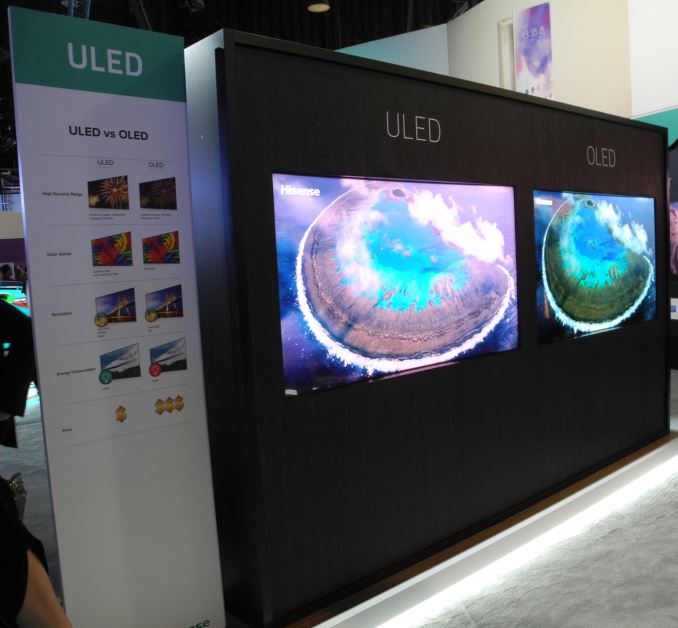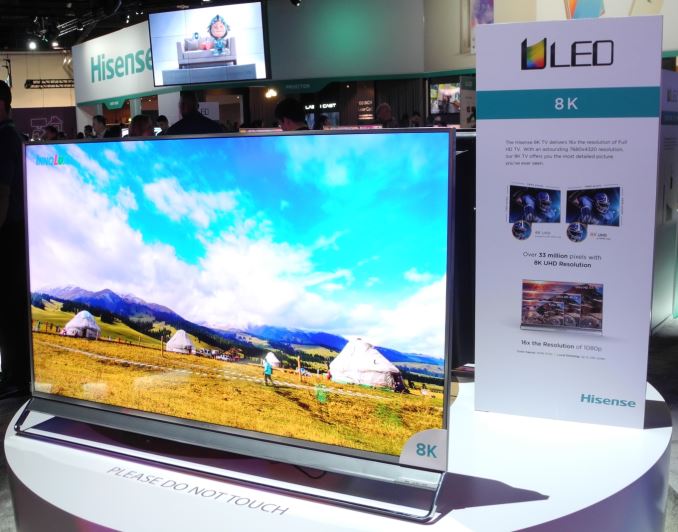Hisense at CES: Affordable and Feature-Packed 4K TVs for HTPCs
by Ganesh T S on January 11, 2016 3:50 AM EST
We usually don't cover televisions in detail here at AnandTech. However, the current flux in the market when it comes to 4K displays for HTPCs made CES 2016 an interesting destination for us to look at what vendors will be offering in the near future. Consumers looking for the best possible picture quality and not concerned about the price have a number of models to choose from in the Smasung SUHDTV series and the Sony XBR series TVs.
Vizio and Hisense 4K TVs are perfect for those on a tight budget. However, a limited budget also means that one can't afford to be an early adopter and be stuck with an outdated television early on. In June 2014, we covered the launch of the Hisense 50H7GB 4K TV. In that article, we covered the minimum features that a 4K HTPC display needed to support in order to not become obsolete within a couple of years. The 50H7GB 50" 4K TV was launched at $600. It supported HDMI 2.0 and HDCP 2.2, with the only disappointing factor being the absence of HDR capabilities. Consumers considering this model obviously have price, and not picture quality, at the top of their purchase factors. In late August 2015, Hisense had launched the H10 series ULED TV with full-array local dimming and quantum dot technologoy for a wider color gamut (the 65" model is currently available for $2500).
At CES 2016, we stopped by Hisense's booth to get an idea of what they had in store for consumers over the rest of the year and what they are working on for future products. The good news is that all the four 4K TV lineups get updated with HDR processing capability - the H7, H8, H9 and H10.
- The new H10 will be similar to the one currently available on Amazon with all the Smart TV and Wi-Fi features, but Hisense hopes to get THX certification for this high-end curved model.
- The H9 (55", $1000, February 2016) gets all the features of the new H10 except that it will not have 3D or quantum dot technology.
- The H8 (50" - $600, 55" - $700, April 2016) is not a curved model. But, Hisense indicates that it will not have the vibrant picture quality of the H9 and H10.
- The H7 (43" - $400, 50" - $550, 55" - $650, 65" - $1300, February 2016) doesn't have the full-array local dimming present in the other models, but carries forward other features from the H8.
It is exciting to see that HDR is making an appearance at mainstream price points. However, wider color gamut is absolutely essential to better appreciate the right 4K content. It might be worthwhile to take a look at the complete specification sheets of the above models before making a purchase decision. Important aspects to track down would be the panel type and panel bitwidth, color gamut coverage and black levels.
Hisense believes that there is a big tussle going on between ULED technology and OLED. To give consumers their perspective, they had the same clip running on a ULED TV as well as an OLED TV side by side in their booth.
To be frank, the OLED TV playback was more pleasing to the eye. However, a side chart indicated that OLEDs have trouble reaching brightness levels that can be achieved via ULED technology. In addition, the quantum dots technology being used in ULED TVs can deliver 106% of the NTSC color gamut, while the best OLEDs can only reach 85% of the NTSC color gamut. While the ULED TV on display was consuming 280W, the equivalent sized OLED TV was consuming 500W. Finally, the OLED TV on display currently costs three times as much as the ULED TV. It would be nice if ULED TVs could further evolve to get some of the more desirable features of OLED TVs - particularly in terms of black levels.
Looking further into the future, Hisense also had a static demo of a 8K model in their booth. Other than the resolution (7680x4320), there was no other information about the television or expected release dates.
As part of their press releases, Hisense also indicated that the Sharp brand is going to be alive and well, and will be around as a premium brand. The N9000, a 70" flat-screen 4K TV with other specifications similar to the H10 series, will come to the market in July for $3000.












18 Comments
View All Comments
ketacdx - Tuesday, January 12, 2016 - link
Thanks for this. I was thinking it but couldn't say it quite as elegantly.Shadow7037932 - Monday, January 11, 2016 - link
It's basically normal LCD but using improved LED back lighting compared to normal LED back lighting.ssj4Gogeta - Monday, January 11, 2016 - link
Way to name things deceptively. I thought ULED was a non-backlit display. Turns out it's just a backlighting technique.bds71 - Monday, January 11, 2016 - link
most LED's (OLED being the exception) are all backlit. technically, OLED is too, but the LED itself is actually the source of the lighting.to be more specific, ULED is simply a "full" panel backlight vs the cheaper models that are edge lit. full backlighting gives better brightness uniformity compared to edge lit (backlight elements are only on one edge of the monitor/TV). while this sounds like a small point, it's actually not. with the addition of quantum dot technology, a fully backlit screen can produce "better than average" color gamut, brightness, and overall picture quality. until I can afford OLED (and convinced they will last more than 5 years) this will be precisely the "type" of screen I will have - though probably in the Samsung SUHDTV or Sony XBR version. (both of which are full backlight, quantum dot screens)
Techguy53 - Tuesday, January 12, 2016 - link
Hisense has a great picture but they suck at sound. With Vizio you can run any speakers off their headphone jack that you want. Not so with Hisense, try that and it will ruin whatever you connect to it with the exception of headphones. Hisense tech support reps are extremely condescending. I will never purchase one of their products again. Vizio is much more end user friendly all around and perhaps even a better picture, remote and menus.cjs150 - Tuesday, January 12, 2016 - link
Personally I am ignoring 4k until all standard TV channels upgrade to Full HD and there is plenty of 4K content around.douglasm - Tuesday, January 12, 2016 - link
These are supposed to be shipping in two weeks (at least the H7 series), and we have yet to see any details of the TVs themselves. How many HDMI inputs? How many support HDMI 2.0a ? What chips is providing the logic? etc.nobozos - Tuesday, January 12, 2016 - link
"in the Smasung SUHDTV series"Is Smasung one of those bizarre clone vendors?